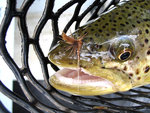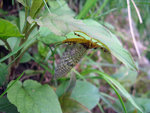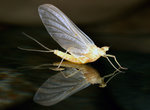 Narrowsburg
NarrowsburgLight Rain Fog/Mist, 43°
Wind: 8.1 mph
 Narrowsburg
NarrowsburgThinking you might like to get started fly fishing for trout? Understanding the “aquatic” insects that are the trout’s the main food is pretty basic. These “bugs” spend …
Stay informed about your community and support local independent journalism.
Subscribe to The River Reporter today. click here
This item is available in full to subscribers.
Please log in to continue |



Thinking you might like to get started fly fishing for trout? Understanding the “aquatic” insects that are the trout’s the main food is pretty basic. These “bugs” spend most of their year-long lives under water, only to emerge to the surface of the river, fly around for a few days, then mate, lay their eggs and die. The fly fisherman tries to fool the wily trout into thinking that an imitation of these insects made of fur and feathers tied to a tiny hook is real enough to gobble and get caught. One of the challenges of fly fishing is picking an imitation that will work, and this article means to help you do this.
The cold, clean water of our beautiful Delaware River supports vast populations of these aquatic insects. Every spring as the days grow longer a progression of insect species emerge from her waters. To the fly fisherman, the arrival of each insect hatch is like catching up with an old friend. Most anglers plan their fishing to coincide with particular hatches when the trout will be avidly feeding on insects floating on the water’s surface, and thus be easier to catch. Fly anglers of all skill levels agree that the challenge of casting a floating fly onto the river’s surface and drawing a wild and wily trout to it is the pinnacle of our sport.
The insect hatching usually begins in mid- to late April. The timing of each species’ emergence varies from year to year, depending on air temperature and river flows. The insects of the most interest to fishermen on the Delaware are mayflies. These are beautiful, delicate insects which, after spending about a year living under water, emerge from the bottom of the river and float for a while on the surface, drying their wings in preparation for their first flight as adults, or duns. It is during this brief float time that the trout will gorge on them, and fisherman will imitate them with a floating, or “dry fly” imitation.
After taking flight, they seek shelter in the trees and vegetation along the river’s edge. Then, after a few days mayflies go through their last metamorphous, to sexually mature “spinners.” In a kind of last dance, the mature mayflies congregate above the water en masse and complete their life cycle by mating and falling to the water with their fertilized eggs.
Their initial emergence and their falling back onto the river surface in the act of laying eggs are the times when mayflies are most vulnerable and available to the trout. Trout know this, and will feed heavily while the emergence or spinner fall is underway. We fishermen too will recognize these best times to be casting our flies. Our goal is to have imitations that duplicate the insects on the water. This is referred to as “match the hatch” fly fishing.
Though the exact timing and duration of the hatches will vary from year to year, the different species of mayflies emerge in the same order. For each species, the period over which the emerging duns are available to the trout varies. Some are prolific and emerge by the millions at very specific times of day, while others emerge sparsely throughout the day. Some will emerge every day over several weeks, while other species emerge in mass over just a few days. During spring it is normal for multiple species to overlap and be on the water at the same time. This is truly a time of plenty for the trout and the angler—but it can get confusing and a bit overwhelming for the novice.
With the beginner in mind, here is an outline of the important spring mayfly hatches with some tips to take some of the uncertainty out of your Delaware excursions.
April into Early May
The first steady surface trout feeding is always to one of three insects, and perhaps to a simultaneous combination of all three. These are the blue quills, the quill Gordons and the Hendricksons. These mayflies emerge when the water is still quite cold, and the action occurs in slower moving water. The emergence often starts in the tail-outs of the pools in mid-afternoon. The duns of these insects look similar, having dark bodies and dark grey wings. You will need both size 12 and size 16 dry-fly duns. Additionally, these early insects have a lot of cripples, misshapen duns that cannot take flight after emergence. Fishing crippled-dun patterns in the same sizes and coloration will get you a lot of takes. This trio of hatches will typically last over a month.
Mid May
March browns are impossible to miss due to their tan coloration and large size. At first, being so much larger than their predecessors, they almost seem out of place. It does not take the trout long to realize that there is a big meal on the water. March browns emerge in smaller numbers throughout the day. They are most often found in and around riffles and pocket water. Once the fish get to feeding on these big boys, you can have great luck blind casting a big March brown dun imitation into the riffles. These insects also emerge especially heavily during cloudy or rainy weather.
The sulfurs also show up in May with two subspecies, one very big and the other pretty small. These bright yellow insects are afternoon emergers that will regularly be on the water until dark. A prolific hatch, they emerge in fishable numbers from May through autumn, and are best imitated with size 14 through size 18 fly patterns.
March browns are impossible to miss due to their tan coloration and large size. At first, being so much larger than their predecessors, they almost seem out of place. It does not take the trout long to realize that there is a big meal on the water. March browns emerge in smaller numbers throughout the day. They are most often found in and around riffles and pocket water. Once the fish get to feeding on these big boys, you can have great luck blind casting a big March brown dun imitation into the riffles. These insects also emerge especially heavily during cloudy or rainy weather.
The sulfurs also show up in May with two subspecies, one very big and the other pretty small. These bright yellow insects are afternoon emergers that will regularly be on the water until dark. A prolific hatch, they emerge in fishable numbers from May through autumn, and are best imitated with size 14 through size 18 fly patterns.
May into June
The green drakes, the brown drakes and the isonychias appear from May into June. The drakes, our biggest mayflies, are absolutely huge, and it is quite a sight when the trout are feeding on them. Drakes are a short-duration hatch that only lasts for a few days. The best locations are slower water with fine-silty bottoms. The spinners of the green drake (the coffin fly) cause heavy feeding just at or after dark. Drakes are best imitated with size 6 to 10 dry flies. During drake time, White Wulffs are a good choice at dark.
The isonychias are a rainbow trout favorite and will be on the water right through autumn. They are another big insect with a dark mahogany body and grey wings; they are best imitated with size 10 through 12 flies. When no hatching or rising fish are observed, isonychia imitations are perhaps the best flies to fish blindly in and around fast water.
While there are many other fly species that may be on the water in spring, the ones outlined above are the big players and are the most important to fly fishermen. Anglers can get up-to-date information on the hatches underway and current river conditions through my daily fishing report at www.baxterhouse.net
[Capt. Ken Tutalo is owner of Baxter House River Outfitters/Fly Shop in Roscoe, NY, and for many years has kept detailed logs of the timing of the insect hatches on the Delaware. 507/290-4022.]
Comments
No comments on this item Please log in to comment by clicking here